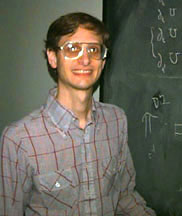
 
|
|
 |
Parallel Profile - Todd J. ArbogastAssociate Professor, Department of Mathematics, University of Texas at Austin |
| Todd Arbogast works in the areas of algorithm development and
numerical analysis of partial differential equations; mathematical modeling
and homogenization of subsurface flow phenomena; high-performance,
parallel, scientific computing; and applied mathematics.
"I have always been attracted to the beauty and consistency of both the physical world and mathematics," says Arbogast. "I began by studying both physics and mathematics, but the lure of abstract mathematics drew me into graduate study in pure mathematics. However, I soon desired to make an impact on real-world applications. It is extremely gratifying to see the physical world within the equations of a mathematical description. Computational science and engineering gives us a powerful tool to investigate the real world and its mathematical description." Arbogast received B.S. degrees in physics and mathematics from the University of Minnesota in 1981, both with high distinction. He received his M.S. and Ph.D. in mathematics from the University of Chicago in 1983 and 1987, respectively. He joined Purdue University in 1987 as a research assistant professor and was an assistant professor there from 1988 until 1991. He was a visiting assistant professor at Rice University (1990-1992), Rice faculty fellow (1992-1993) and an assistant and associate professor at Rice until 1995. In 1995, he joined the University of Texas Department of Mathematics as an associate professor. Arbogast has been a CRPC researcher since 1990, specializing in the modeling and simulation of flow through hetrogeneous and fractured porous media. He also is a member of the Texas Institute for Computational and Applied Mathematics (TICAM), a research unit established by the University of Texas to foster interdisciplinary research in broad areas of computational science and computational and applied mathematics. He participates in TICAM's Center for Numerical Analysis and Center for Subsurface Modeling (CSM). The CSM investigates high-performance parallel processing as a tool to model the behavior of fluids in permeable geologic formations, including petroleum and natural gas reservoirs and groundwater aquifers and aquitards, and in shallow water such as bays and estuaries. "Probably the most significant contribution in my career has been in formulating the mathematical structure of fluid flow in highly fractured petroleum reservoirs, and simulating it computationally," says Arbogast. "Flow in such reservoirs is extremely scale-dependent. The microscopic fractures carry very little oil, but at a much faster rate compared to flow in the porous rock. So, the fractures cannot be neglected. However, a microscopic description of flow on the scale of the fractures-micrometers-would be impossible to understand over several kilometers of the reservoir; it would also be impossible to compute. A careful modeling of the essential physics resolves the dilemma and allows us to simulate the flow and visualize the results." Arbogast is active in several professional societies, including the Society for Industrial and Applied Mathematics (SIAM) and the Society of Petroleum Engineers (SPE). He has authored or co-authored more than 50 journal articles and technical reports and lectures regularly at universities, conferences, and meetings. His honors and awards include The President's Associates Centennial Teaching Fellowship in Mathematics (1997-1998) at The University of Texas at Austin; the National Science Foundation (NSF) Mathematical Sciences Postdoctoral Research Fellowship (1989-1992) at the University of Houston and Rice; the Robert R. McCormick Fellowship (1981-1984) at the University of Chicago; Sigma Pi Sigma (physics) and Tau Beta Pi (engineering) honor society membership and the Century Fund Scholarship (1976-1977) at the University of Minnesota. Arbogast is a member of the CRPC Technical Steering Committee. Of his participation in the center, Arbogast says, "The CRPC has been great for me in that it has stimulated my activities and enabled me to exchange ideas with scientists I would not likely have come in contact with otherwise." |
|
 Other Issues of
PCR Other Issues of
PCR |  Back to PCR Back to PCR |  CRPC Home Page CRPC Home Page |